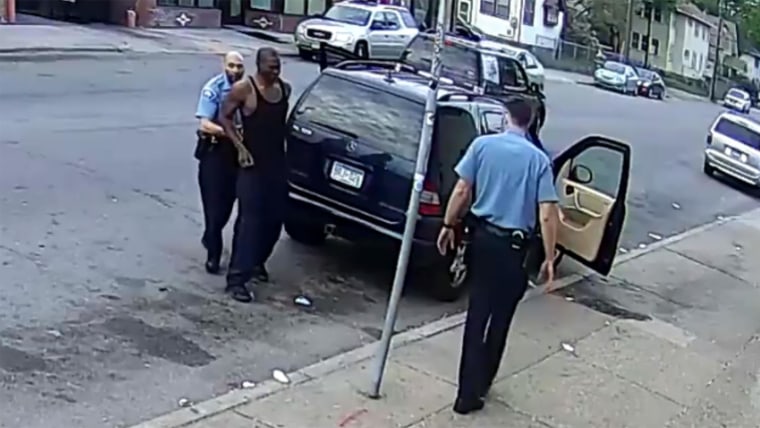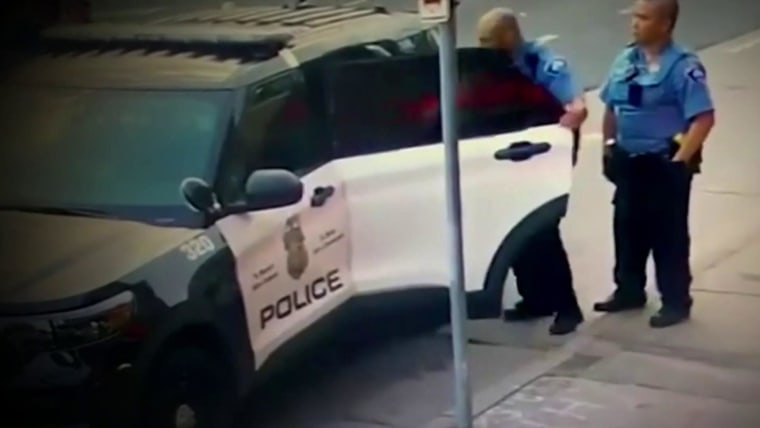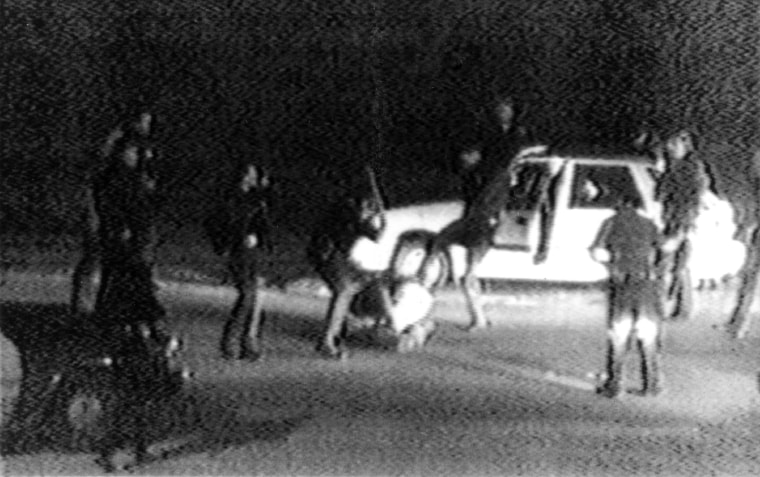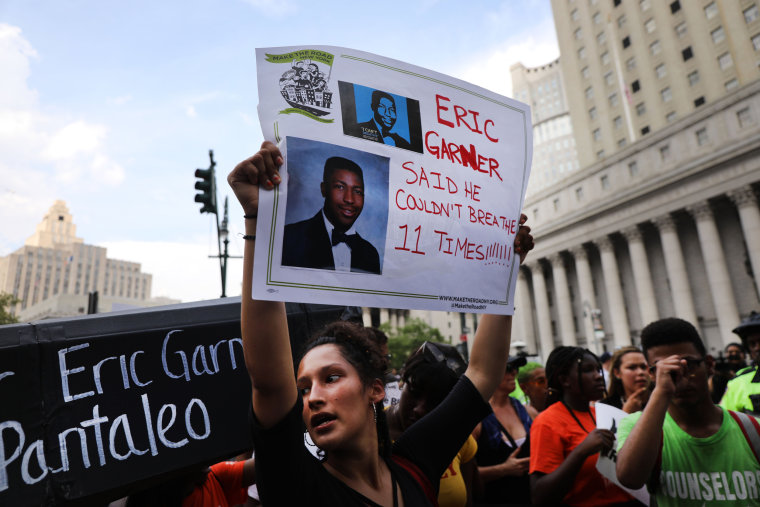Several police experts said that number appears to be unusually high. "By using this tactic, it's a self-fulfilling tragedy," said one.

A protester in Minneapolis on Thursday, May 28, 2020.Julio Cortez / AP
GEORGE FLOYD DEATH
June 1, 2020
By Emily R. Siegel, Andrew W. Lehren and Andrew Blankstein
Police define neck restraints as when an officer uses an arm or leg to compress someone's neck without directly pressuring the airway. On May 25, Minneapolis Police Officer Derek Chauvin was captured on video kneeling on the neck of a prone and handcuffed George Floyd for eight minutes — including nearly three minutes after he had stopped breathing.
Chauvin was charged Friday with third-degree murder and manslaughter for Floyd's death.
More than a dozen police officials and law enforcement experts told NBC News that the particular tactic Chauvin used — kneeling on a suspect's neck — is neither taught nor sanctioned by any police agency. A Minneapolis city official told NBC News Chauvin's tactic is not permitted by the Minneapolis police department. For most major police departments, variations of neck restraints, known as chokeholds, are highly restricted — if not banned outright.
GEORGE FLOYD DEATH
June 1, 2020
By Emily R. Siegel, Andrew W. Lehren and Andrew Blankstein
Since the beginning of 2015, officers from the Minneapolis Police Department have rendered people unconscious with neck restraints 44 times, according to an NBC News analysis of police records. Several police experts said that number appears to be unusually high.
Minneapolis police used neck restraints at least 237 times during that span, and in 16 percent of the incidents the suspects and other individuals lost consciousness, the department's use-of-force records show. A lack of publicly available use-of-force data from other departments makes it difficult to compare Minneapolis to other cities of the same or any size.
Police define neck restraints as when an officer uses an arm or leg to compress someone's neck without directly pressuring the airway. On May 25, Minneapolis Police Officer Derek Chauvin was captured on video kneeling on the neck of a prone and handcuffed George Floyd for eight minutes — including nearly three minutes after he had stopped breathing.
Chauvin was charged Friday with third-degree murder and manslaughter for Floyd's death.
More than a dozen police officials and law enforcement experts told NBC News that the particular tactic Chauvin used — kneeling on a suspect's neck — is neither taught nor sanctioned by any police agency. A Minneapolis city official told NBC News Chauvin's tactic is not permitted by the Minneapolis police department. For most major police departments, variations of neck restraints, known as chokeholds, are highly restricted — if not banned outright.
Related
Nation's police widely condemn move used to restrain George Floyd
The version of the Minneapolis Police Department's policy manual that is available on-line, however, does permit the use of neck restraints that can render suspects unconscious, and the protocol for their use appears not to have been updated for more than eight years.
Live updates on George Floyd's death and protests around the country.
Minneapolis police data shows that in the bulk of use-of-force cases involving neck restraints when an individual lost consciousness, the restraint was used after a suspect fled on foot or tensed up as they were being taken into custody. Almost half of the people who lost consciousness were injured, according to the reports, which do not spell out the severity of those injuries.
Five of the cases involved assaults on officers, while several others involved domestic abuse or domestic assault cases. In most cases, there was no apparent underlying violent offense.

Watch a minute-to-minute breakdown leading up to George Floyd's deadly arrest
The version of the Minneapolis Police Department's policy manual that is available on-line, however, does permit the use of neck restraints that can render suspects unconscious, and the protocol for their use appears not to have been updated for more than eight years.
Live updates on George Floyd's death and protests around the country.
Minneapolis police data shows that in the bulk of use-of-force cases involving neck restraints when an individual lost consciousness, the restraint was used after a suspect fled on foot or tensed up as they were being taken into custody. Almost half of the people who lost consciousness were injured, according to the reports, which do not spell out the severity of those injuries.
Five of the cases involved assaults on officers, while several others involved domestic abuse or domestic assault cases. In most cases, there was no apparent underlying violent offense.

Watch a minute-to-minute breakdown leading up to George Floyd's deadly arrest
MAY 28, 2020
The Minnesota police data showed three-fifths of those subjected to neck restraints and then rendered unconscious were black. About 30 percent were white. Two were Native Americans. Almost all are male, and three-quarters were age 40 or under.
One was a 14-year-old in a domestic abuse incident that was in progress when the officer arrived. Another was a 17-year-old fleeing from a shoplifting incident. Another involved a traffic stop where the suspect was deemed "verbally non-compliant."
The on-line version of the policy manual says, "The unconscious neck restraint shall only be applied … 1. On a subject who is exhibiting active aggression, or; 2. For life saving purposes, or; 3. On a subject who is exhibiting active resistance in order to gain control of the subject; and if lesser attempts at control have been or would likely be ineffective."
The passage includes a date in parentheses, April 16, 2012. The front of the manual is dated July 28, 2016.
The Minnesota police data showed three-fifths of those subjected to neck restraints and then rendered unconscious were black. About 30 percent were white. Two were Native Americans. Almost all are male, and three-quarters were age 40 or under.
One was a 14-year-old in a domestic abuse incident that was in progress when the officer arrived. Another was a 17-year-old fleeing from a shoplifting incident. Another involved a traffic stop where the suspect was deemed "verbally non-compliant."
The on-line version of the policy manual says, "The unconscious neck restraint shall only be applied … 1. On a subject who is exhibiting active aggression, or; 2. For life saving purposes, or; 3. On a subject who is exhibiting active resistance in order to gain control of the subject; and if lesser attempts at control have been or would likely be ineffective."
The passage includes a date in parentheses, April 16, 2012. The front of the manual is dated July 28, 2016.

George Floyd died May 25 after being pinned to the ground by an officer who put his knee on the man's neck for about eight minutes.Darnella Frazier
The Minneapolis Police Department did not immediately provide comment on the data, and did not respond to a request to confirm that the dates in parentheses refer to when the manual and its sections were updated.
Download the NBC News app for full coverage and alerts on this story
Ed Obayashi, an attorney and the deputy sheriff in Plumas County, California, is a national use-of-force expert who trains and advises California police agencies. He said police departments across the country have been moving away from the neck restraint option for many years because of its "inherent life-threatening potential" and because officers often misinterpret resistance by a suspect, who may simply be struggling to breathe.
"It's common sense," Obayashi said. "Any time you cut off someone's airway or block blood flow to the brain, it can lead to serious injury or death as we have seen in so many of these tragedies. By using this tactic, it's a self-fulfilling tragedy."

Video appears to show George Floyd in struggle in police vehicle
JUNE 1, 202001:36
Obayashi said it's notable that the Minneapolis Police Department policy on neck restraints appears to be dated and said that rather than discouraging or generally prohibiting the tactic, its policy language is consistent with a permissive stance.
"The [Minneapolis] policy doesn't appear to reflect what California and other law enforcement agencies using best practices recognize, which is if officers don't use extreme caution with this force option, the likelihood of serious injury or death rises significantly," Obayashi said.
"This seems to be a routine practice by the Minneapolis Police Department," said Obayashi. "As a cop, the tone is there, 'Use it when you think it's appropriate.'"
Shawn Williams, an assistant professor and professional peace officer coordinator at St. Cloud State University in Minnesota, worked at the Minneapolis Police Department for more than 10 years and oversaw training his last two years there, including the use of unconscious neck restraints. He said he understands why other departments do not use the maneuver.

The Minneapolis Police Department did not immediately provide comment on the data, and did not respond to a request to confirm that the dates in parentheses refer to when the manual and its sections were updated.
Download the NBC News app for full coverage and alerts on this story
Ed Obayashi, an attorney and the deputy sheriff in Plumas County, California, is a national use-of-force expert who trains and advises California police agencies. He said police departments across the country have been moving away from the neck restraint option for many years because of its "inherent life-threatening potential" and because officers often misinterpret resistance by a suspect, who may simply be struggling to breathe.
"It's common sense," Obayashi said. "Any time you cut off someone's airway or block blood flow to the brain, it can lead to serious injury or death as we have seen in so many of these tragedies. By using this tactic, it's a self-fulfilling tragedy."

Video appears to show George Floyd in struggle in police vehicle
JUNE 1, 202001:36
Obayashi said it's notable that the Minneapolis Police Department policy on neck restraints appears to be dated and said that rather than discouraging or generally prohibiting the tactic, its policy language is consistent with a permissive stance.
"The [Minneapolis] policy doesn't appear to reflect what California and other law enforcement agencies using best practices recognize, which is if officers don't use extreme caution with this force option, the likelihood of serious injury or death rises significantly," Obayashi said.
"This seems to be a routine practice by the Minneapolis Police Department," said Obayashi. "As a cop, the tone is there, 'Use it when you think it's appropriate.'"
Shawn Williams, an assistant professor and professional peace officer coordinator at St. Cloud State University in Minnesota, worked at the Minneapolis Police Department for more than 10 years and oversaw training his last two years there, including the use of unconscious neck restraints. He said he understands why other departments do not use the maneuver.

This March 31, 1991 frame from a video tape shot by George Holliday from his apartment in a suburb of Los Angeles shows a group of police officers beating a man with nightsticks and kicking him as other officers look on. The April 29, 1992 acquittal of four police officers in the beating of Rodney King sparked rioting that spread across the city and into neighboring suburbs. George Holliday / Courtesy of KTLA Los Angeles / AP, file
"If it's used correctly, you can cause the suspect to render themselves compliant and we can take someone into custody without damage internally," he said. "If it's not used correctly, and the arm is placed in the wrong place, you're talking about damage to one's trachea and you're talking about taking someone's life."
During his time in the department, he said officers needed to be trained correctly, often and while under stress so they could fully understand how to use the move.
Richard Drooyan served as counsel to the Christopher Commission, which investigated the LAPD beating of Rodney King, and later on the independent panel that examined the Rampart Division corruption scandal. Drooyan, who now oversees the L.A. County jail, said neck restraint should only be employed when there is an urgent matter of life or death, and that the number of times it was used by the Minneapolis Police Department seemed "extraordinary."

"If it's used correctly, you can cause the suspect to render themselves compliant and we can take someone into custody without damage internally," he said. "If it's not used correctly, and the arm is placed in the wrong place, you're talking about damage to one's trachea and you're talking about taking someone's life."
During his time in the department, he said officers needed to be trained correctly, often and while under stress so they could fully understand how to use the move.
Richard Drooyan served as counsel to the Christopher Commission, which investigated the LAPD beating of Rodney King, and later on the independent panel that examined the Rampart Division corruption scandal. Drooyan, who now oversees the L.A. County jail, said neck restraint should only be employed when there is an urgent matter of life or death, and that the number of times it was used by the Minneapolis Police Department seemed "extraordinary."

People participate in a protest to mark the five year anniversary of the death of Eric Garner during a confrontation with a police officer in the borough of Staten Island on July 17, 2019 in New York City.Spencer Platt / Getty Images
"In many cases," he said, "the justification was that the suspect tensed up, which I read to mean resisted arrest or fled on foot without any indication that the suspect was armed or dangerous. You have a combination of a large number of incidents involving the use of neck restraints on individuals who were not engaged in violent criminal activity and appeared to have been restrained because they appeared to be resisting arrest."
Despite a turbulent past, the LAPD was one of the first police agencies to address deadly or excessive force incidents that grew out of using chokeholds. In 1982, at the request of then-Chief Daryl F. Gates, the department banned the bar-arm chokeholds and limited upper-body controls, then commonplace, after a federal lawsuit. Sixteen people — including a dozen African-American men — died from various forms of upper-body controls over a seven-year period leading up to the decision.
The Los Angeles Police Commission followed up the bar-arm ban weeks later by restricting the carotid chokehold, designed to immobilize a suspect by blocking the neck artery and, by extension, the flow of blood to the brain. The department still allows officers to use a carotid restraint but limits those situations to immediate danger to life.
Related
"In many cases," he said, "the justification was that the suspect tensed up, which I read to mean resisted arrest or fled on foot without any indication that the suspect was armed or dangerous. You have a combination of a large number of incidents involving the use of neck restraints on individuals who were not engaged in violent criminal activity and appeared to have been restrained because they appeared to be resisting arrest."
Despite a turbulent past, the LAPD was one of the first police agencies to address deadly or excessive force incidents that grew out of using chokeholds. In 1982, at the request of then-Chief Daryl F. Gates, the department banned the bar-arm chokeholds and limited upper-body controls, then commonplace, after a federal lawsuit. Sixteen people — including a dozen African-American men — died from various forms of upper-body controls over a seven-year period leading up to the decision.
The Los Angeles Police Commission followed up the bar-arm ban weeks later by restricting the carotid chokehold, designed to immobilize a suspect by blocking the neck artery and, by extension, the flow of blood to the brain. The department still allows officers to use a carotid restraint but limits those situations to immediate danger to life.
Related
Eric Garner's mom says video of man's police death is 'reoccurring nightmare'
Use of unconscious neck restraints is not specifically referenced in the New York Police Department patrol guide. On July 17, 2014, Eric Garner died after he was put in a chokehold by New York Police Officer Daniel Pantaleo while under arrest for selling loose, untaxed cigarettes in New York's Staten Island.
A chokehold is prohibited by the NYPD in the normal course of policing, but in a self-defense situation officers are allowed to use whatever technique is appropriate. NYPD procedure for use-of-force states that officers "take necessary action to protect life and personal safety of all persons present, including subjects being placed into custody."
Pantaleo was fired from the department. A state grand jury and federal prosecutors both declined to bring charges against him. The Garner family settled a lawsuit against the city for $5.9 million.
Use of unconscious neck restraints is not specifically referenced in the New York Police Department patrol guide. On July 17, 2014, Eric Garner died after he was put in a chokehold by New York Police Officer Daniel Pantaleo while under arrest for selling loose, untaxed cigarettes in New York's Staten Island.
A chokehold is prohibited by the NYPD in the normal course of policing, but in a self-defense situation officers are allowed to use whatever technique is appropriate. NYPD procedure for use-of-force states that officers "take necessary action to protect life and personal safety of all persons present, including subjects being placed into custody."
Pantaleo was fired from the department. A state grand jury and federal prosecutors both declined to bring charges against him. The Garner family settled a lawsuit against the city for $5.9 million.
--------------------
Emily Siegel is an associate producer with the NBC News Investigative Unit.
Andrew W. Lehren is a senior editor with the NBC News Investigative Unit.
Andrew Blankstein is an investigative reporter for NBC News. He covers the Western United States, specializing in crime, courts and homeland security.
Tom Winter contributed.
No comments:
Post a Comment